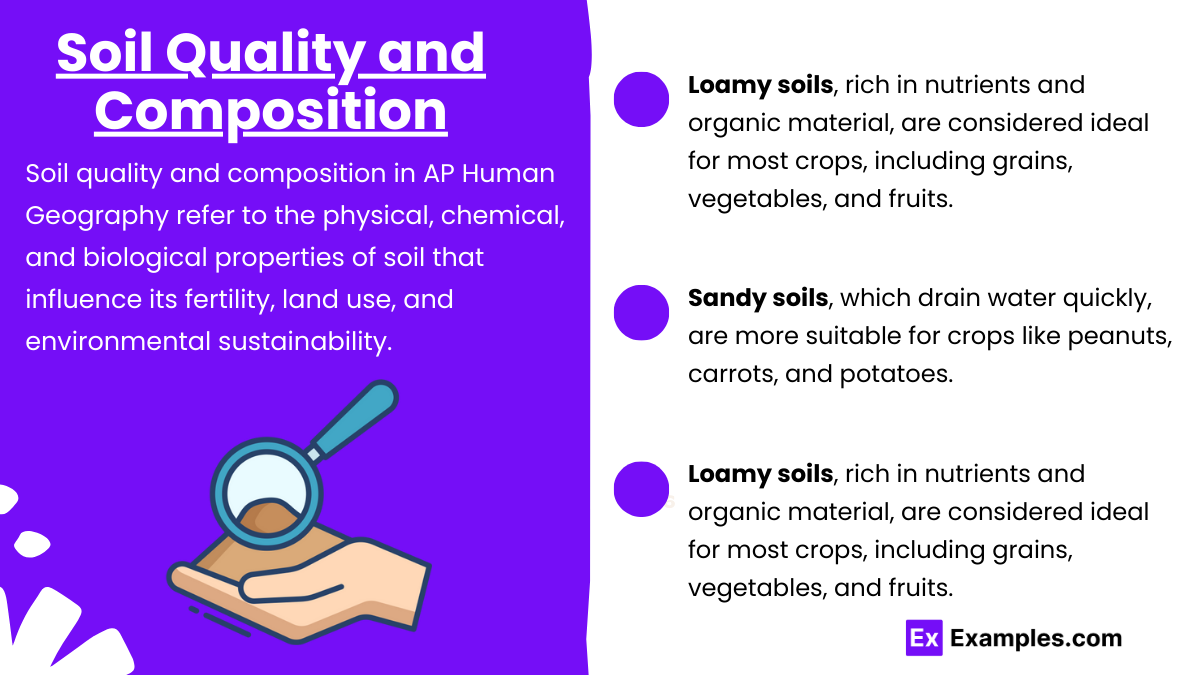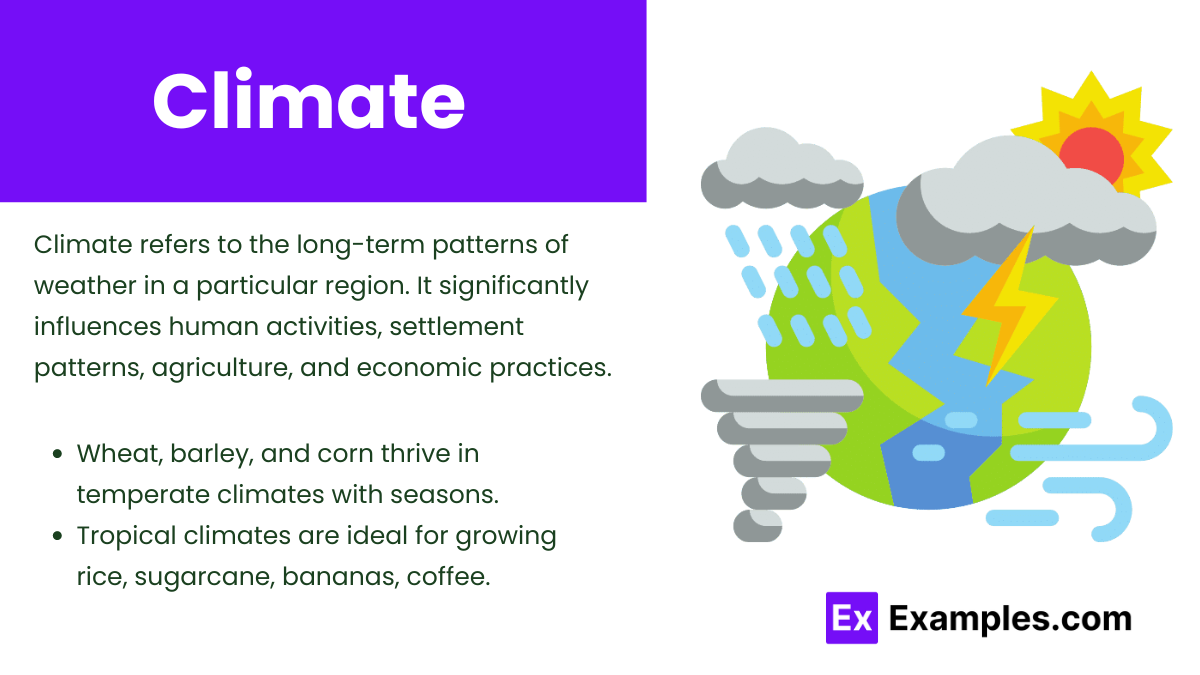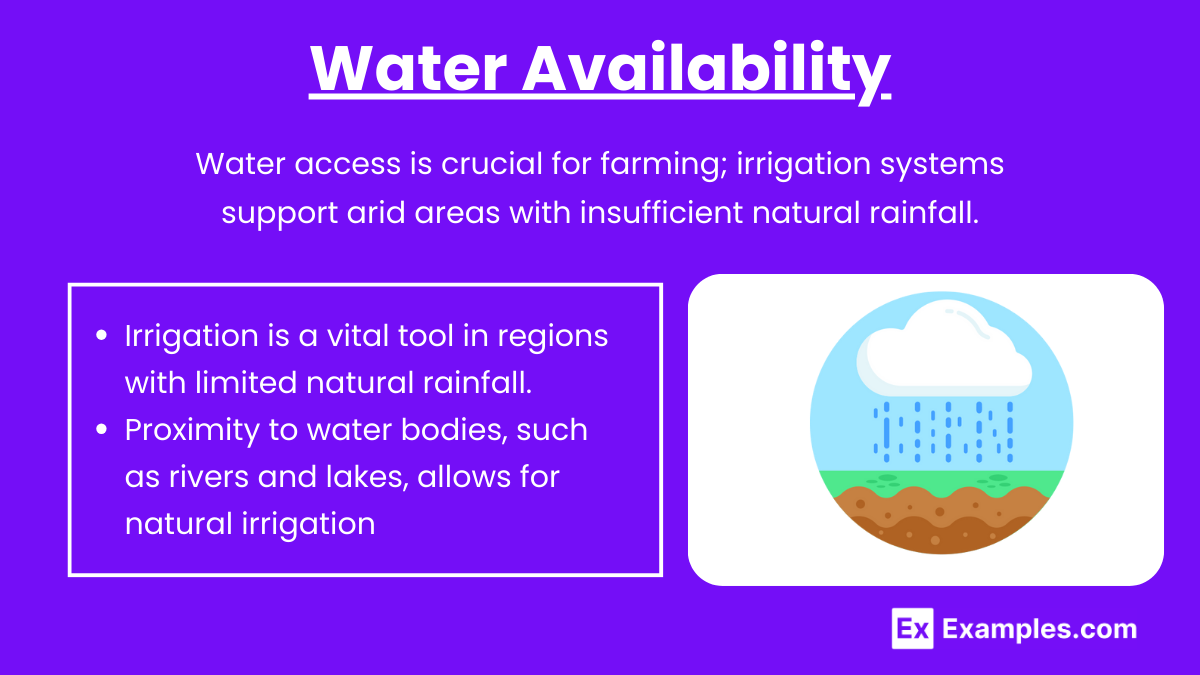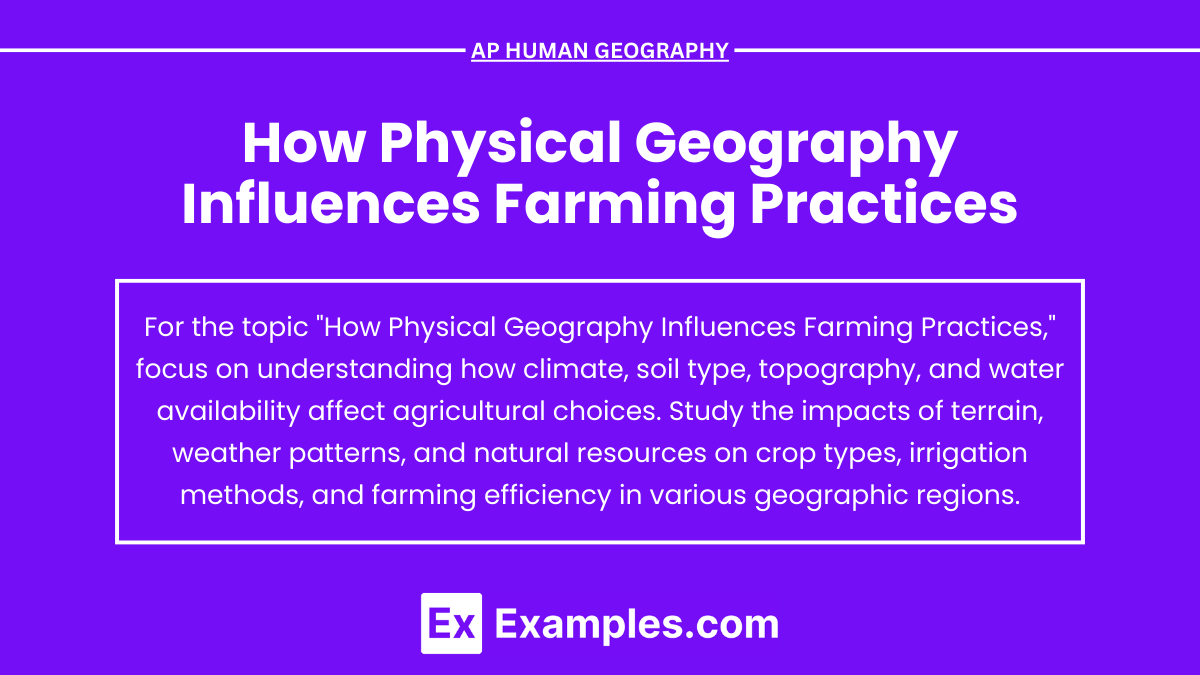Physical geography significantly shapes farming practices by influencing factors such as soil quality, climate, topography, and water availability. In AP Human Geography, these elements are crucial to understanding how regions develop distinct agricultural methods. Climate dictates growing seasons, while topography affects the use of machinery and irrigation systems. Soil type and water access also play essential roles in crop selection and productivity. Understanding these physical factors is vital for analyzing agricultural patterns and predicting how environmental changes impact farming worldwide.
Learning Objectives
When studying how physical geography influences farming practices, you should learn how factors like soil composition, climate, topography, and water availability shape agricultural methods. Understand how different physical environments lead to distinct farming systems, such as terracing in mountainous regions or irrigation in arid areas. You should also examine the role of natural hazards, such as floods or droughts, and how farmers adapt to these challenges. Additionally, explore the connection between physical geography and the spatial distribution of crop types and farming efficiency.
How Physical Geography Influences Farming Practices
Physical geography plays a critical role in shaping farming practices by influencing factors such as soil type, climate, topography, and water availability. Farmers must adapt to the natural environment to maximize crop yields and efficiency, often leading to distinct agricultural patterns in different regions.
Soil Quality and Composition

Soil quality and composition in AP Human Geography refer to the physical, chemical, and biological properties of soil that influence its fertility, land use, and environmental sustainability.The type of soil affects what crops can be grown in a region. For example, loamy soils, rich in organic matter, are ideal for crop farming, while sandy soils are better suited for crops like peanuts and root vegetables. Soil pH, nutrient levels, and drainage capacity also influence farming decisions. Soils vary in their organic content, mineral composition, pH levels, and water retention capabilities.
- Loamy soils, rich in nutrients and organic material, are considered ideal for most crops, including grains, vegetables, and fruits. These soils have balanced texture and structure, allowing for good water retention and drainage, which is crucial for plant growth.
- Sandy soils, which drain water quickly, are more suitable for crops like peanuts, carrots, and potatoes. Farmers growing these crops must often implement irrigation systems to prevent the soil from drying out.
- Clay soils, which retain water but drain poorly, may be better suited for rice farming, particularly in areas that experience frequent flooding, such as Southeast Asia.
Climate

climate refers to the long-term patterns of weather in a particular region. It significantly influences human activities, settlement patterns, agriculture, and economic practices. Climate is shaped by factors like latitude, elevation, proximity to water bodies, and prevailing winds, and it directly affects the availability of resources, types of crops grown, and the design of infrastructure. Temperature, rainfall, and growing seasons are pivotal in determining which crops can be cultivated. In temperate climates, grains like wheat and barley thrive, while tropical climates with high humidity and consistent rainfall are suited for crops such as rice, sugarcane, and coffee. Climate also dictates the length of the growing season and the types of farming techniques used, such as irrigation in arid regions or crop rotation in areas with distinct seasonal variations.
- In temperate climates with distinct seasons, crops like wheat, barley, and corn are commonly grown, as they require cooler temperatures and moderate rainfall. The length of the growing season influences the type of crop and when it can be planted and harvested.
- Tropical climates, characterized by warm temperatures and high humidity, are ideal for growing rice, sugarcane, bananas, and coffee. These regions often support year-round farming due to the consistent availability of water and warmth.
- In arid or semi-arid climates, such as the Middle East or parts of Africa, farming relies heavily on irrigation to supply water to crops like dates, cotton, and wheat. Drip irrigation and desalination are used in these areas to conserve water and sustain crop production despite low rainfall.
Topography

The shape and elevation of land affect farming techniques. In mountainous or hilly regions, terracing is often used to prevent soil erosion and create flat areas for planting. In contrast, flat plains are ideal for large-scale mechanized farming, such as wheat or corn farming in the U.S. Midwest. The landscape’s physical features, such as elevation, slope, and relief, play a significant role in determining the type of agriculture that can be practiced.
- In mountainous regions, such as the Andes or the Himalayas, terracing is a common agricultural technique. Terracing involves carving steps into the mountainsides to create flat surfaces for planting crops. This technique helps prevent soil erosion, conserves water, and allows farming in areas where traditional flat farming would be impossible.
- In contrast, plains and flatlands, such as those found in the U.S. Midwest, are ideal for large-scale, mechanized farming. Here, crops like corn, wheat, and soybeans are grown extensively using advanced agricultural machinery for planting, irrigation, and harvesting.
- In river valleys, where soil is naturally fertile due to regular flooding, farming systems such as floodplain agriculture are commonly practiced. For example, in the Nile River Valley, farmers have historically relied on seasonal floods to irrigate and fertilize their fields.
Water Availability

Access to water is one of the most significant physical factors in farming. Irrigation systems are developed in areas where natural rainfall is insufficient, such as the arid regions of the Middle East. Farming practices near rivers or lakes may rely on natural flooding to provide water and nutrients to the soil, such as in the Nile Delta region.
- Irrigation is a vital tool in regions with limited natural rainfall. Techniques such as drip irrigation, sprinkler systems, and canal-based irrigation are employed to maximize water use efficiency and sustain crop growth in water-scarce areas. For example, in California’s Central Valley, extensive irrigation networks support the growth of crops like almonds, grapes, and citrus fruits, despite the region’s semi-arid climate.
- Proximity to water bodies, such as rivers and lakes, allows for natural irrigation. Farming near rivers often relies on flood irrigation, where fields are flooded to water the crops, as seen in the Indus River Valley in Pakistan and the Mekong Delta in Vietnam.
- In regions without reliable rainfall, farmers may use aquifers or underground reservoirs for irrigation. However, overuse of groundwater resources can lead to environmental issues like soil salinization and land subsidence.
Examples
Example 1: Terracing in Mountainous Regions
In areas with steep slopes, such as the Andes in South America or the Himalayas in Asia, farmers utilize terracing to adapt to the topography. By creating step-like flat surfaces on the mountainside, they can cultivate crops like potatoes, rice, and maize. Terracing prevents soil erosion and helps in water retention, which is essential for farming on sloped land where water runoff would otherwise wash away soil and nutrients.
Example 2: Irrigation in Arid Climates
In desert or semi-arid regions, like the Central Valley of California or parts of the Middle East, farmers rely heavily on irrigation to compensate for low rainfall. Water is sourced from rivers, reservoirs, or underground aquifers to support the growth of crops such as cotton, almonds, and tomatoes. Without access to irrigation, these regions would be unsuitable for large-scale farming due to insufficient natural precipitation.
Example 3: Shifting Cultivation in Tropical Rainforests
In tropical rainforest areas, like the Amazon Basin, shifting cultivation (also known as slash-and-burn agriculture) is a common practice. Farmers clear a section of forest by cutting and burning vegetation, then plant crops like cassava, yams, or maize. After a few years of cultivation, the soil becomes depleted of nutrients, and farmers move to a new area, allowing the original plot to regenerate.
Example 4: Floodplain Agriculture in River Valleys
In regions such as the Nile River Valley in Egypt or the Ganges Delta in India, farmers take advantage of seasonal flooding for agriculture. The floods deposit nutrient-rich silt onto the fields, replenishing the soil with vital minerals for crops like rice and wheat. These natural flood cycles are essential for maintaining soil fertility, allowing for sustained agricultural production over centuries.
Example 5: Pastoralism in Semi-Arid Grasslands
In regions with semi-arid climates, like the Sahel in Africa or the Great Plains in the United States, pastoralism (raising livestock) is more common than crop farming. The dry, open grasslands provide natural grazing areas for cattle, sheep, and goats. Due to limited rainfall and poor soil conditions for crops, farmers in these areas focus on animal husbandry, moving their herds seasonally in search of fresh grazing pastures.
Multiple Choice Questions
Question 1
Which of the following physical factors is most likely to influence the decision to use terracing in farming practices?
A) Temperature
B) Soil pH
C) Topography
D) Precipitation
Answer: C) Topography
Explanation: Terracing is a farming method used on sloped land to prevent soil erosion and manage water runoff. This practice involves creating flat “steps” on hillsides, which allows farmers to cultivate crops on otherwise difficult terrain. While temperature, soil pH, and precipitation can influence farming in other ways, topography directly impacts whether terracing is needed. Hilly or mountainous areas, like the Andes or Southeast Asia, are known for using terracing to make the land arable.
Question 2
Which of the following crops is most likely to be grown in regions with loamy, nutrient-rich soil and a temperate climate?
A) Coffee
B) Rice
C) Wheat
D) Sugarcane
Answer: C) Wheat
Explanation: Wheat is commonly grown in regions with loamy, nutrient-rich soils and a temperate climate. These conditions are optimal for cereal crops, such as wheat, which require well-drained soil and moderate temperatures for successful growth. Crops like coffee and sugarcane are typically grown in tropical or subtropical climates, while rice is suited to regions with high rainfall and areas that can sustain flooding, such as river valleys or coastal plains.
Question 3
In which type of region would you most likely find agricultural practices that rely heavily on irrigation systems?
A) Tropical rainforest regions
B) Arid or semi-arid regions
C) Mountainous regions
D) Coastal regions with seasonal flooding
Answer: B) Arid or semi-arid regions
Explanation: Irrigation systems are essential in arid or semi-arid regions where natural rainfall is insufficient to support crops. Farmers use irrigation to artificially supply water to fields, allowing agriculture to flourish even in areas with limited precipitation. Examples include the use of irrigation in the Middle East or southwestern United States. Tropical rainforest regions typically have abundant rainfall, while mountainous regions may rely on different farming methods like terracing, and coastal regions with seasonal flooding can benefit from natural water cycles.


